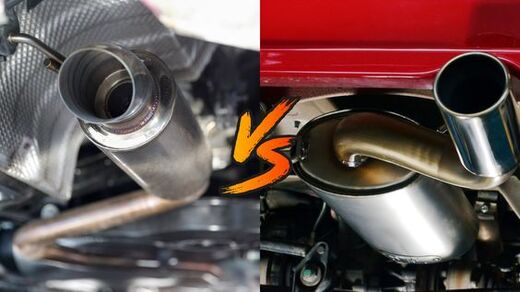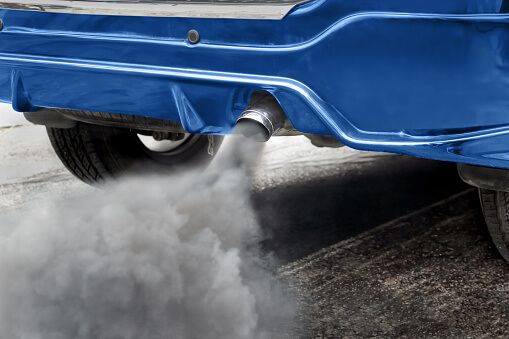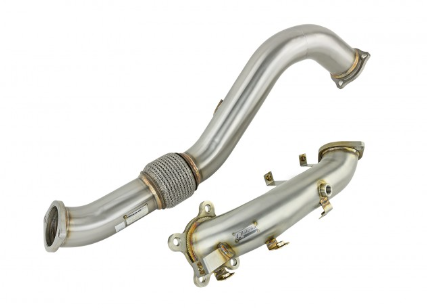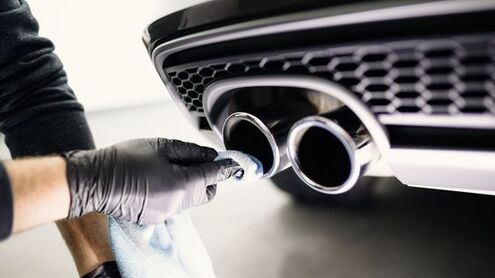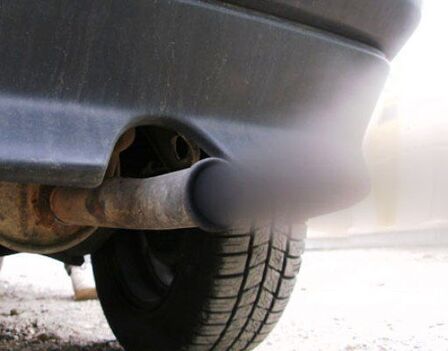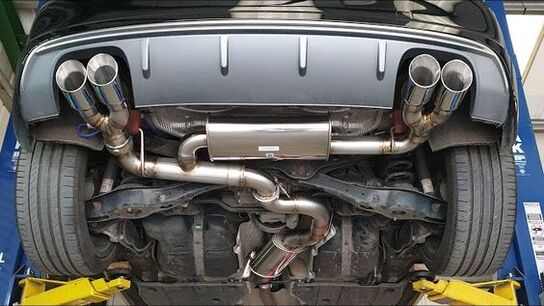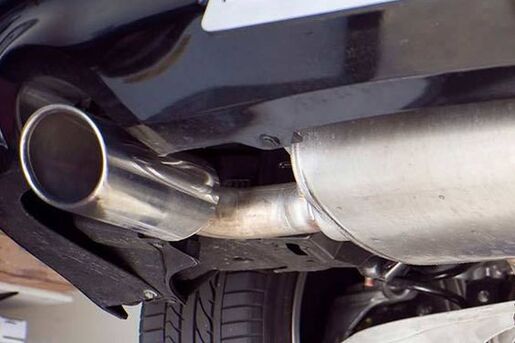|
In the world of auto tuning, understanding the components that contribute to your vehicle's performance is essential. Two commonly misunderstood elements are the muffler and resonator. While they both play crucial roles in exhaust system design, they serve different purposes. In this article, we will explore the differences between mufflers and resonators, helping you make informed decisions when fine-tuning your vehicle's performance.
What is a Muffler? A muffler, also known as a silencer, is an integral part of the exhaust system. Its primary purpose is to reduce noise produced by the engine's exhaust gases. The muffler achieves this by utilizing chambers, baffles, and sound-absorbing materials to dampen and redirect sound waves. As a result, the muffler helps to maintain a quieter and more comfortable driving experience. The Role of Resonators: Resonators, on the other hand, serve a different function in the exhaust system. Resonators are designed to eliminate specific frequencies of sound that may cause unwanted resonances or droning noises. They work by creating destructive interference with the sound waves, effectively canceling out the frequencies that cause resonance. This process helps to produce a smoother and more refined exhaust note. Sound Control: While both mufflers and resonators contribute to sound control, they target different aspects. Mufflers primarily focus on reducing overall noise levels, whereas resonators target specific frequencies to eliminate drone and enhance the exhaust tone. Depending on your preferences, vehicle type, and intended use, you may choose to incorporate mufflers, resonators, or both to achieve the desired sound output. Exhaust Flow and Performance: Another significant difference between mufflers and resonators lies in their impact on exhaust flow and performance. Mufflers create backpressure in the exhaust system, restricting the flow of exhaust gases. This backpressure can help increase torque at lower RPMs but may limit high-end horsepower. Resonators, however, have a minimal effect on backpressure and are more focused on sound attenuation. Therefore, if optimizing performance is your primary goal, a resonator may be a better choice. Customization and Personalization: Both mufflers and resonators offer opportunities for customization and personalization. Various designs and materials can be used to achieve specific sound characteristics, allowing you to tailor your vehicle's exhaust note to your preferences. Consulting with professionals who specialize in auto tuning can help you determine the ideal combination of mufflers and resonators to achieve the desired sound and performance results. Understanding the differences between mufflers and resonators is vital for optimizing your vehicle's exhaust system. While mufflers primarily focus on reducing overall noise levels, resonators target specific frequencies to eliminate drone and enhance the exhaust tone. By considering your desired sound output, performance goals, and consulting with professionals, you can make informed decisions about incorporating mufflers and resonators into your auto tuning endeavors. Visit our Electronic Repair Company blog for more expert insights on automotive maintenance and performance optimization. Remember, when it comes to auto tuning, striking the right balance between sound control, performance, and personalization is key.
0 Comments
Exhaust smoke is the visible emission produced by vehicles that can indicate the overall health of the engine. It can tell you if the engine is running properly or not. Different types of exhaust smokes can indicate different problems in the engine. In this article, we will discuss the different types of exhaust smokes and what they mean.
Different types of exhaust smokes can indicate different problems in the engine. If you see any type of smoke coming from the exhaust, you should get your vehicle checked by a professional mechanic. Ignoring the problem can lead to more serious and expensive engine damage. Regular maintenance and timely repairs can help prevent these problems and keep your vehicle running smoothly. The downpipe is a critical component of any high-performance exhaust system, responsible for carrying exhaust gases from the turbocharger or catalytic converter to the rest of the exhaust system. In this technical article, we will explore the basics of downpipes, including what they are, the different types available, how to install them, and their advantages and disadvantages. What is a Downpipe? A downpipe is a component of an exhaust system that connects the turbocharger or catalytic converter to the rest of the exhaust system. It is typically made of stainless steel or aluminum and is designed to be lightweight and efficient. Downpipes come in different shapes and sizes depending on the vehicle and application. Types of Downpipes: There are two main types of downpipes:
How to Install a Downpipe: Installing a downpipe can be a challenging process and requires some mechanical knowledge. The installation process typically involves removing the old downpipe, installing the new downpipe, and connecting it to the rest of the exhaust system. It is important to ensure that the downpipe is properly aligned and tightened to prevent leaks or damage to the exhaust system. Advantages and Disadvantages of Downpipes: Advantages:
Downpipes are a critical component of any high-performance exhaust system, allowing for increased exhaust flow and improved performance. They come in different types and sizes, including catless downpipes and high-flow catalytic converter downpipes. While installation can be challenging, the advantages of increased performance, enhanced sound, and improved fuel efficiency make them a popular choice for performance enthusiasts. However, it is important to consider the potential drawbacks, such as increased noise and reduced emissions compliance, before installing a downpipe. Oil coming out of the exhaust can be a concerning issue for any vehicle owner. Not only does it indicate potential engine problems, but it can also lead to decreased performance and increased maintenance costs. In this article, we will delve into the common causes of oil coming out of the exhaust and provide effective solutions to address the issue. Whether you are a car enthusiast or a novice driver, understanding the underlying factors behind this problem is crucial for maintaining the health of your vehicle.
Worn Piston Rings: One of the primary reasons for oil escaping into the exhaust system is worn piston rings. These rings are responsible for maintaining the proper seal between the pistons and cylinder walls, preventing oil from entering the combustion chamber. When the rings wear out, oil can slip past them and mix with the fuel, leading to oil emission through the exhaust. Replacing the worn piston rings is necessary to resolve this issue. Damaged Valve Seals: Faulty or damaged valve seals can also contribute to oil escaping into the exhaust. Valve seals help regulate the flow of oil into the combustion chamber. If they become worn or damaged, excessive oil can enter the exhaust system, resulting in oil smoke and a distinct burning oil smell. Replacing the valve seals is essential to prevent further oil leakage. Engine Overfill: Overfilling the engine with oil beyond the recommended levels can cause excessive pressure and push oil into the exhaust system. This can lead to oil leaks and subsequent oil emissions. It is crucial to adhere to the manufacturer's guidelines for oil capacity and perform regular oil changes to prevent overfilling. PCV Valve Issues: The Positive Crankcase Ventilation (PCV) valve is responsible for regulating the airflow within the engine and preventing the buildup of pressure. If the PCV valve malfunctions or becomes clogged, it can cause an increase in crankcase pressure, leading to oil being forced into the exhaust system. Regular maintenance and replacing a faulty PCV valve can mitigate this issue. Blown Head Gasket: A blown head gasket can be a severe issue that leads to oil mixing with coolant and entering the exhaust system. This is often accompanied by other symptoms such as overheating, white smoke, and engine misfires. Repairing or replacing the blown head gasket is necessary to resolve the problem and prevent further engine damage. Identifying and addressing the root causes of oil coming out of the exhaust is essential for maintaining the performance and longevity of your vehicle. Whether it's worn piston rings, damaged valve seals, engine overfill, PCV valve issues, or a blown head gasket, understanding these common factors allows for timely intervention and effective solutions. Regular maintenance, adherence to manufacturer guidelines, and seeking professional assistance when needed are crucial for preventing oil leakage and ensuring a smooth driving experience. For more expert insights on auto tuning, maintenance, and repair, visit the Electronic Repair Company Blog. Remember, taking care of your vehicle is not just about the present; it's an investment in its future reliability and performance. Is your car's exhaust emitting thick black smoke? This alarming sign indicates potential problems that require immediate attention. In this article, we will delve into the causes, symptoms, and effective solutions for black smoke from your car's exhaust. At Electronic Repair Company, we are committed to providing you with comprehensive information to address this issue promptly and efficiently.
Understanding the Causes: a. Fuel System Issues: Clogged Fuel Injectors: Dirty or clogged fuel injectors can disrupt the proper fuel-to-air ratio, resulting in incomplete combustion and black smoke. Faulty Fuel Pressure Regulator: A malfunctioning fuel pressure regulator can lead to excessive fuel delivery, causing black smoke. b. Engine Problems: Air Filter Blockage: A clogged air filter restricts airflow to the engine, leading to a rich fuel mixture and black smoke. Malfunctioning Mass Airflow (MAF) Sensor: A faulty MAF sensor may inaccurately measure incoming air, causing an imbalanced fuel mixture and black smoke. c. Ignition System Malfunctions: Faulty Spark Plugs: Worn-out or damaged spark plugs can cause inefficient combustion, leading to black smoke from the exhaust. Failing Ignition Coils: Malfunctioning ignition coils may result in misfires, causing unburned fuel to produce black smoke. Identifying Symptoms: Thick, dark smoke from the exhaust pipe, often accompanied by a strong fuel odor. Decreased fuel efficiency and power output. Rough idling and engine performance issues. Presence of black, sooty deposits on the tailpipe. Effective Solutions: a. Regular Maintenance: Schedule periodic tune-ups to ensure the proper functioning of the fuel and ignition systems. Replace air filters and spark plugs as recommended by your vehicle manufacturer. b. Fuel System Cleaning: Use high-quality fuel additives or have a professional fuel system cleaning to eliminate carbon deposits and restore optimal performance. c. MAF Sensor Cleaning or Replacement: Consult a qualified mechanic to clean or replace the MAF sensor if necessary to restore accurate airflow measurement. d. Professional Diagnostics and Repairs: If the issue persists, seek assistance from a trusted auto repair professional like Electronic Repair Company. They will conduct a comprehensive diagnosis using advanced equipment to pinpoint the exact problem and provide the necessary repairs. Black smoke from your car's exhaust is a warning sign that shouldn't be ignored. Understanding the causes, identifying the symptoms, and implementing effective solutions can prevent further damage to your vehicle and improve its overall performance. For prompt and reliable assistance, trust the experts at Electronic Repair Company to diagnose and resolve the issue efficiently. Visit our blog now for more valuable insights and comprehensive solutions. The car's exhaust system is responsible for removing the gases produced during the combustion process from the engine and releasing them into the atmosphere. The exhaust system is a critical component of the car's performance, sound, and environmental impact. In this article, we'll delve into the technical aspects of car exhaust systems, including headers, downpipes, straight pipes, sounds, environmental impact, engine efficiency, and effects.
Headers: Headers are a component of the exhaust system that replaces the car's factory exhaust manifold. The primary function of headers is to increase the exhaust flow rate, which can improve engine performance. Headers typically have larger diameter tubing, smoother bends, and shorter lengths than factory exhaust manifolds. This allows the exhaust gases to flow more freely, reducing exhaust backpressure, and increasing engine efficiency. Downpipes: Downpipes are a component of the exhaust system that connects the headers to the catalytic converter. Downpipes can be replaced with high-flow aftermarket versions that improve exhaust flow and engine performance. High-flow downpipes have larger diameter tubing, smoother bends, and fewer restrictions than factory versions, allowing the exhaust gases to flow more freely and reducing exhaust backpressure. Straight Pipes: Straight pipes are a type of exhaust system that does not include any mufflers or resonators, allowing the exhaust gases to flow freely from the engine to the atmosphere. Straight pipes can produce a louder exhaust sound, but they can also increase exhaust emissions and reduce engine efficiency. Straight pipes are often used in racing cars or for aesthetic purposes. Sounds: The exhaust sound is a critical aspect of a car's character and can be influenced by various components of the exhaust system, such as headers, downpipes, mufflers, and resonators. Different configurations of the exhaust system can produce different sounds, ranging from deep and throaty to high-pitched and raspy. The sound produced by the exhaust system can also affect the car's performance, as the sound waves can create backpressure, which can reduce engine efficiency. Environmental Impact: The exhaust system's environmental impact is a critical concern, as the gases released into the atmosphere can contribute to air pollution and climate change. The primary gases produced by the car's engine are carbon dioxide, carbon monoxide, nitrogen oxides, and hydrocarbons. These gases can have adverse effects on the environment and human health, such as smog, acid rain, and respiratory problems. The car's exhaust system can be modified with aftermarket components that reduce emissions, such as high-flow catalytic converters and exhaust gas recirculation systems. Engine Efficiency and Effects: The exhaust system's effect on engine efficiency is a critical consideration, as the exhaust gases' flow rate can influence the engine's performance. The exhaust gases' flow rate can be influenced by various components of the exhaust system, such as headers, downpipes, and mufflers. High-performance exhaust systems can increase engine efficiency by reducing exhaust backpressure and allowing the engine to breathe more freely, producing more power and torque. However, modifying the exhaust system can also have adverse effects, such as reducing fuel efficiency, increasing emissions, and altering the engine's sound and character. Header Design: Headers come in various designs, such as short-tube, mid-length, and long-tube. Short-tube headers are the most common type and provide good performance gains across the entire RPM range. Mid-length headers provide similar gains but are easier to install and have better ground clearance. Long-tube headers provide the most significant gains but require extensive modification to install and can reduce low-end torque. Catalytic Converters: Catalytic converters are a critical component of the exhaust system that reduces emissions by converting harmful gases into less harmful ones. High-flow catalytic converters are available that reduce backpressure and improve performance, but they can be illegal in some areas due to their reduced emissions control. Some car enthusiasts choose to remove the catalytic converter altogether for performance gains, but this is illegal and can result in hefty fines. Mufflers and Resonators: Mufflers and resonators are components of the exhaust system that reduce exhaust noise. Mufflers work by reducing sound pressure levels, while resonators work by reducing specific frequencies. High-performance mufflers and resonators are available that provide good sound reduction while still allowing the exhaust gases to flow freely. Exhaust Tips: Exhaust tips are the visible part of the exhaust system that exits the rear of the car. They come in various shapes and sizes and can significantly affect the car's appearance. Exhaust tips can also be modified to improve exhaust flow and performance. Backpressure: Backpressure is the resistance to exhaust flow in the exhaust system. High backpressure can reduce engine performance, as it restricts the flow of exhaust gases. Low backpressure can reduce exhaust noise but can also reduce engine efficiency. Finding the right balance between backpressure and exhaust flow is crucial to achieving the desired performance gains. Car exhaust systems are a complex and critical component of a car's performance and environmental impact. Understanding the different components of the exhaust system and their effects on performance, emissions, and sound can help car enthusiasts make informed decisions about modifying their exhaust systems. However, it's important to remember that modifications to the exhaust system can have adverse effects on the car's emissions and may not be legal in some areas. Welcome to the Electronic Repair Company Blog! In this comprehensive guide, we will explore the symptoms of an exhaust leak in your vehicle and provide you with valuable insights to diagnose and address this issue. Whether you're a car enthusiast or a vehicle owner seeking to enhance your automotive knowledge, this article will equip you with the information you need to identify and resolve exhaust leaks effectively.
What is an Exhaust Leak? Before diving into the symptoms, it's essential to understand what an exhaust leak entails. An exhaust leak occurs when there is a gap or break in the exhaust system, allowing harmful gases to escape before they pass through the catalytic converter. This can lead to various performance issues and potential dangers if left unaddressed. Common Symptoms of an Exhaust Leak: 2.1. Unusual Engine Noises: One of the primary indicators of an exhaust leak is the presence of unusual engine noises. Listen for hissing, popping, or loud rumbling sounds, particularly when the engine is running. These noises typically originate from the area where the leak is occurring. 2.2. Strong Exhaust Smell: If you notice a pungent odor resembling rotten eggs or sulfur coming from your vehicle's exhaust, it may be a sign of an exhaust leak. The distinct smell is caused by the release of hydrogen sulfide gas. Take note of any strong smells both inside and outside the car. 2.3. Decreased Fuel Efficiency: An exhaust leak can negatively impact your vehicle's fuel efficiency. If you find yourself making more frequent trips to the gas station, it's worth considering whether an exhaust leak could be the culprit. Keep an eye on your fuel consumption and note any significant changes. 2.4. Engine Performance Issues: Exhaust leaks can disrupt the proper functioning of your engine, leading to performance issues such as decreased power, sluggish acceleration, or misfires. If you experience any of these symptoms, an exhaust leak could be a potential cause. Diagnosing and Resolving Exhaust Leaks: 3.1. Visual Inspection: Begin by visually inspecting the exhaust system for any visible signs of damage, such as cracks, holes, or disconnected components. Take note of the location and severity of the leak to facilitate the repair process. 3.2. Using Soapy Water: Another effective method to identify exhaust leaks is by using soapy water. With the engine running, apply a mixture of water and liquid soap along the suspected areas. If bubbles form, it indicates the presence of a leak. 3.3. Seeking Professional Help: While some minor exhaust leaks can be addressed as DIY projects, it is often recommended to seek professional assistance, especially for complex repairs. An experienced mechanic will have the expertise and equipment to diagnose the issue accurately and provide a reliable solution. Identifying and addressing symptoms of an exhaust leak promptly is crucial for maintaining your vehicle's performance and ensuring the safety of both you and your passengers. By familiarizing yourself with the common symptoms outlined in this article, you can be proactive in detecting and resolving exhaust leaks. Remember to consult a professional if you're unsure or if the issue requires expert attention. Follow the Electronic Repair Company Blog for more valuable insights, expert tips, and comprehensive guides on automotive tuning and repair. Stay tuned for future articles that will further enhance your automotive knowledge and help you keep your vehicle in top-notch condition. |
Auto Tuning Blog “The content provided is for educational and informational purposes only.”
Categories
All
|
Please note that we don't accept Orders / support requests sent direct to our email address.
Electronic Repair Company |
|
|
All Rights Reserved, ©2024 Electronic Repair Company
